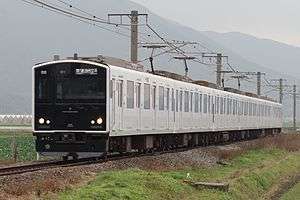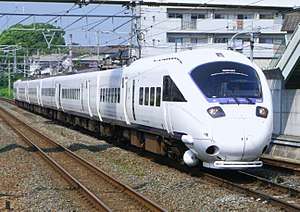305 series
The 305 series (305系) is a DC electric multiple unit (EMU) commuter train type operated by Kyushu Railway Company (JR Kyushu) on Chikuhi Line and Fukuoka Subway Kuko Line through-running services in Kyushu, Japan, since 5 February 2015.[1] The entire fleet of six six-car sets (36 vehicles) was scheduled to be in service by the start of the 14 March 2015 timetable revision.[2]
| 305 series | |
|---|---|
 305 series set W1 on the Chikuhi Line in January 2016 | |
| In service | 5 February 2015 |
| Manufacturer | Hitachi |
| Built at | Kudamatsu, Yamaguchi |
| Replaced | 103-1500 series |
| Constructed | 2014-2015 |
| Number built | 36 vehicles (6 sets) |
| Number in service | 36 vehicles (6 sets) |
| Formation | 6 cars per trainset |
| Fleet numbers | W1-W6 |
| Capacity | 851 |
| Operator(s) | JR Kyushu |
| Depot(s) | Karatsu |
| Line(s) served | Chikuhi Line, Fukuoka Subway Kuko Line |
| Specifications | |
| Car body construction | Aluminium |
| Car length | 20,250 mm (66 ft 5 in) (end cars) 20,000 mm (65 ft 7 in) (intermediate cars) |
| Width | 2,800 mm (9 ft 2 in) |
| Height | 4,050 mm (13 ft 3 in) |
| Floor height | 1,125 mm (3 ft 8.3 in) (1,140 mm (3 ft 9 in) for car 1) |
| Doors | 4 pairs per side |
| Maximum speed | 110 km/h (70 mph) |
| Traction motors | PMSM motors |
| Electric system(s) | 1,500 V DC |
| Current collection method | Overhead catenary |
| Safety system(s) | ATS-SK, ATC, ATO |
| Track gauge | 1,067 mm (3 ft 6 in) |
Design

The fleet of 36 vehicles (six six-car sets) will be built by Hitachi at a cost of approximately 5.7 billion yen, with styling overseen by industrial designer Eiji Mitooka.[3] The new trains are designed to offer improved universal accessibility.[4] Fully enclosed permanent-magnet synchronous motors (PMSM) are used to reduce environmental noise and reduce power consumption by approximately 57% compared with existing 103 series trains.[2]
Operations
The 305 series trains are used on through services between Nishi-Karatsu the Chikuhi Line and Fukuokakūkō on the Fukuoka Subway Kuko Line, replacing older 103-1500 series sets.[1][3]
Formations
The 305 series trains are formed as six-car sets as shown below, numbered W1 to W6, consisting of four motored intermediate cars and two non-powered driving trailer cars.[5] Car 1 is at the Nishi-Karatsu end.[5]
| Car No. | 1 | 2 | 3 | 4 | 5 | 6 |
|---|---|---|---|---|---|---|
| Designation | Tc | M | Mp | M1 | M1p | T'c |
| Numbering | KuHa 305 | MoHa 305 | MoHa 304 | MoHa 305-100 | MoHa 304-100 | KuHa 304 |
| Weight (t) | 29.5 | 33.0 | 30.8 | 33.0 | 30.7 | 27.3 |
| Capacity (total/seated) | 128/42 | 147/51 | 147/51 | 147/51 | 147/51 | 135/45 |
Cars 3 and 5 each have two PS402K single-arm pantographs.[5]
Interior
Passenger accommodation consists of longitudinal bench seating with space for wheelchairs or strollers in each car.[4] Each row of seats has a different seat cover design.[2] Large liquid-crystal display screens are used for providing passenger information, and LED lighting is used throughout.[4] Car 1 features wooden flooring of the same design as that used in JR Kyushu's luxury cruising train Seven Stars in Kyushu.[2] Car 1 also has a universal access toilet.[1] The side doors are equipped with passenger-operated open/close buttons, and these are normally available for use between Misakigaoka and Nishi-Karatsu stations on the Chikuhi Line.[2]
 The interior of KuHa 305-3 (car 1 of set W3) with wooden flooring, February 2015
The interior of KuHa 305-3 (car 1 of set W3) with wooden flooring, February 2015 The interior of MoHa 305-3 (car 2 of set W3) with conventional flooring, February 2015
The interior of MoHa 305-3 (car 2 of set W3) with conventional flooring, February 2015
History
The first set, numbered W1, was delivered from the manufacturer Hitachi in Kudamatsu, Yamaguchi to JR Kyushu's Kokura Depot in November 2014,[6] and moved to Karatsu Depot in December 2014.[7]
A special public preview run was held on 31 January 2015, ahead of the formal entry into service on 5 February.
Fleet details
As of 1 October 2015, the fleet consists of six sets as follows.[9]
| Set No. | Manufacturer | Date delivered |
|---|---|---|
| W1 | Hitachi | 15 December 2014 |
| W2 | Hitachi | 18 December 2014 |
| W3 | Hitachi | 9 February 2015 |
| W4 | Hitachi | 15 February 2015 |
| W5 | Hitachi | 25 February 2015 |
| W6 | Hitachi | 3 March 2015 |
References
- 305系通勤形直流電車 [305 series DC commuter EMU]. Japan Railfan Magazine (in Japanese). 55 (647): 75. March 2015.
- JR九州 新型電車305系が筑肥線で運転開始 [New JR Kyushu 305 series trains enter service on Chikuhi Line]. Tetsudō Daiya Jōhō Magazine (in Japanese). 44 (371): 70–71. March 2015.
- 新型車両・305系、JR筑肥線に導入へ [New 305 series trains to be introduced on JR Chikuhi Line]. Yomiuri Online (in Japanese). Japan: The Yomiuri Shimbun. 1 August 2014. Archived from the original on 6 August 2014. Retrieved 1 August 2014.
- "JR九州 筑肥線に305系通勤型直流電車投入" [JR Kyushu to introduce 305 series DC commuter trains on Chikuhi Line]. Tetsudo Hobidas (in Japanese). Japan: Neko Publishing. 1 August 2014. Retrieved 1 August 2014.
- Matsunaga (June 2015). 305系通勤形直流電車 [305 series DC commuter EMU]. Japan Railfan Magazine (in Japanese). 55 (650): 58–61.
- 305系が甲種輸送される [305 series delivered]. Japan Railfan Magazine Online (in Japanese). Japan: Koyusha Co., Ltd. 25 November 2014. Retrieved 5 February 2015.
- 305系W1編成が唐津へ [305 series set W1 moved to Karatsu]. Japan Railfan Magazine Online (in Japanese). Japan: Koyusha Co., Ltd. 3 December 2014. Retrieved 3 December 2014.
- JR電車編成表 2016冬 [JR EMU Formations - Winter 2016] (in Japanese). Japan: Kotsu Shimbunsha. 18 November 2015. p. 222. ISBN 978-4-330-62315-3.
External links
| Wikimedia Commons has media related to 305 series. |
- JR Kyushu press release (31 July 2014) (in Japanese)
